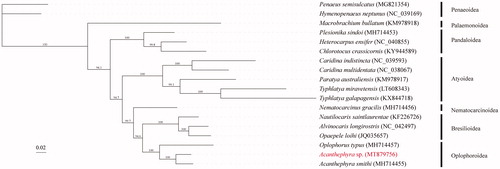Abstract
The genus Acanthephyra mainly inhabits deep waters with the maximum depth exceeding 5000 m. It has a wide distribution, except in high latitude areas. Here, we report the mitochondrial genome of Acanthephyra sp. which was collected from the northeast of South China Sea. The genome is 16,205 bp in length with a 61.52% AT content. It contains 13 protein-coding genes (PCGs), 2 ribosomal RNA genes, and 22 transfer RNA genes. Phylogenetic analysis shows that the present species is closest to A. smithi and Oplophoroidea has a close relationship with Bresilioidea in Caridea.
The genus Acanthephyra (Milne-Edwards, Citation1881) comprises 27 species and is considered to be existing in the meso- and bathypelagic zones of the oceans (Kemp Citation1939; Crosnier and Forest Citation1968, Citation1973; Milne-Edwards Citation1881; Smith Citation1885; Chace Citation1986; Bate Citation1888; De Grave and Fransen Citation2011). Most species of the genus have morphological adaptations to pelagic lifestyle, such as natatory exopods and slightly calcified carapace (Bauer Citation2004; Cardoso Citation2013). In this study, the complete mitochondrial genome from a deep-sea Acanthephyra sp. was described, and its relationship with close related species was investigated.
The specimen was collected from the northeast of South China Sea (117°55′42″E, 20°59′43″N, 1302 m depth) and was identified as Acanthephyra sp. based on its morphological characters. This species is considered to be a new species and will be named within the next six months. The specimen (SRSIO19050306) and its DNA (DNASIO19050306) are deposited in the Sample Repository of the Second Institute of Oceanography, Ministry of Natural Resources, Hangzhou, China. DNA was extracted with QIAamp Tissue Kit (QIAGEN, Hilden, Germany) and mitochondrial DNA was amplified with a DNA REPLI-g Mitochondrial DNA Kit (QIAGEN, Hilden, Germany) as directed by the manufacturer. Library construction and sequencing were performed by Biozeron (Biozeron, Shanghai, China) using the Illumina Hiseq4000 sequencing platform (Illumina, San Diego, CA).
The complete mitogenome sequence of Acanthephyra sp. is 16,205 bp in length with a 61.52% AT content. It contains 13 protein-coding genes (PCGs), 2 ribosomal RNA genes, and 22 transfer RNA genes. Among the 37 genes, both rRNA genes (rrnL and rrnS) are encoded on the light strand, as in the other crustacean mitochondrial genomes. Eight tRNA genes (trnC-tgc, trnF-ttc, trnH-cac, trnL1-cta, trnP-cca, trnQ-caa, trnV-gta, and trnY-tac) are encoded on the light strand. Only four PCGs (nad1, nad4, nad4L, and nad5) are encoded on the light strand, whereas the other nine PCGs are located on the heavy strand. Five PCGs (atp8, nad2, nad3, nad4, and nad4L) are initiated by ATT. Three PCGs (cob, cox2, and cox3) are started by ATG. Three PCGs (atp6, nad1, and nad5) are started by ATA. The remaining two PCGs (cox1 and nad6) are initiated by ATC. Nine PCGs (atp6, nad5, nad6, cox2, cox3, atp8, nad2, nad3, and nad4L) terminate with the typical TAA as stop codon, while three PCGs (nad1, cox1, and cob) end with TAG. Only one PCG (nad4) terminate with the abbreviated stop codon T. A total of 22 transfer RNA genes range in size from 60 to 73 bp. The mitogenome of Acanthephyra sp. has been deposited in GenBank under accession number MT879756.
In order to explore the phylogenetic relationship of Acanthephyra sp. with the other shrimps, a total of 17 mitochondrial genomes from Decapoda were obtained from the GenBank database. The mitochondrial PCGs were used for phylogenetic analysis by maximum likelihood (ML) method. In the phylogenetic tree, Acanthephyra sp. was closely related to A. smithi, and they clustered with Oplophorus typus into a branch. Meanwhile, Oplophoroidea had a close relationship with Bresilioidea in Caridea (). In this study, we present the complete mitochondrial genome sequence of Acanthephyra sp., which would contribute to further comparative mitogenome studies of Caridea. Besides, more mitochondrial genomic data and further analysis are required to reveal phylogeny and evolution of shrimps.
Disclosure statement
No potential conflict of interest was reported by the author(s).
Data availability statement
All sequences generated or used in this study are deposited in NCBI GenBank (www.ncbi.nlm.nih.gov/) and the accession numbers are detailed in .
Additional information
Funding
References
- Bate CS. 1888. Report on the Crustacea Macrura collected by the challenger during the years 1873–76. In Report on the scientific results of the voyage of H.M.S. challenger during the years 1873–76. Vol. 24. Buffalo (WY): Creative Media Partners, LLC; p. 1–942.
- Bauer R. 2004. Remarkable shrimps, adaptations and natural history of the carideans. Oklahoma: University of Oklahoma Press; p. 282.
- Cardoso IA. 2013. On some rare Oplophoridae (Caridea, Decapoda) from the South mid-Atlantic ridge. Latin Am J Aquat Res. 41:209–216.
- Chace FA. 1986. The Caridean shrimps (Crustacea: Decapoda) of the Albatross Philippine expedition, 1907–1910, part 4: families Oplophoridae and Nematocarcinidae. Smithson Contribut Zool. 432(432):1–82.
- Crosnier A, Forest J. 1968. Note préliminaire sur les carides recueillis par l'Ombango au large du plateau continental, du Gabon à l'Angola (Crustacea Decapoda Natantia). Bull Mus natl hist nat. 2(39):1123–1147.
- Crosnier A, Forest J. 1973. Les crevettes profondes de l'Atlantique oriental tropical. Faune Trop. 19:1–409.
- De Grave S, Fransen CHJM. 2011. Carideorum catalogus: the recent species of the dendrobranchiate, stenopodidean, procarididean and caridean shrimps (Crustacea: Decapoda). Zool Mededelingen Leiden. 85:195–589.
- Kemp S. 1939. On Acanthephyra pupurea and its allies (Crustacea Decapoda: Hoplophoridae). Ann Magaz Nat Hist Ser. 4(24):568–579.
- Milne-Edwards A. 1881. Description de quelques crustacés macroures provenant des grandes profondeurs de la Mer des Antilles. Ann Des Sci Nat Ser. 6(11):1–15.
- Smith SI. 1885. On some new or little known Decapod Crustacea, from recent fish commission dredgings off the east coast of the United States. Proc US Natl Museum. 7(455):493–511.

